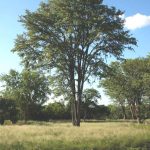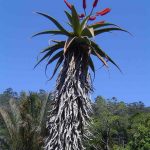TREE LIFE
March 1987
MASHONALAND CALENDAR
Tuesday March 3rd : Botanic Garden Extension, Christon Bank. There is so much to see here that we must insist that members walk to the Mazowe River and botanize on the way back. Last time we enjoyed the journey there so much that some of us never saw the Chionanthus and Ilex along the river. We can spend the afternoon closer to the car park. We will go out in our own cars so meet at the Monomatapa Car Park at 0900 hours where a security guard will be arranged. All members are asked to contribute to this expense.
.Sunday March 29th : Sable Park Kwekwe. The Midland’s Branch of the Wildlife Society have arranged an official opening of the viewing platforms at Sable Park at 1000 hours. Tree Society is a life member of Sable Park and our last visit there was a great success, Combretum eleagnoides, I do recall. It may be worth going for the weekend and camping, there is a caravan park at Dutchman’s Pool and Echo Park, perhaps interested members could phone Kim or Phil at 8871413.
Sunday May 17th : AGM at Spey Bey. Please would anyone who would like to help the committee contact myself or anyone else on the committee, we desperately need willing volunteers.
BOTANIC GARDEN WALK, 2ND MARCH 1987
I taught Tree Architecture based on the growth models of Hall, Oldman and Tomlinson. These modals teach so much about the strategy of growth and excellent examples occur in the gardens. This fascinating field is too complex to write up in a newsletter though, I hope the members enjoyed the different outlook.
THE HURLEY’S FARM, CENTENARY, 24-25 JANUARY 1987 :
Our two long trips this month produced two road guides for botanizing along the way. I would appreciate some feedback, as did you use them, where were they weak and how could they be improved? Would anyone like to see more of these guides?
A Road Guide from Harare to Concession : These short notes are designed for you to take along the road, and look around along the way.
1km peg The road between Harare and Mazowe lies on a “Greenstone Belt”, the oldest type of rock we have in Zimbabwe. These rocks were formed by layers of larva that poured out onto the surface of the earth and once covered the whole land. Today they don’t cover much area because about 35 000 million years ago molten rock welled up from below and buckled all the greenstones, turning them on edge so that in place they now form ridges like Mount Hampden over on the left.
14 This hillside was the original site for Harare but a muddling of instructions changed history. The new molten rock never reached the surface to flow over the larva, instead it solidified while still underground to form either gneiss or granite. Since then the greenstone has been eroded away and the granites have
18.5 been exposed, way over to the east the bare granite rock that only just shows above the ridge of greenstone is Domboshawa. An expanse of gneiss lies way over to the west and so the road travels north on a belt of greenstone. This rock weathers to form fertile red soils excellent for maize.
The woodland on the right is called Miombo Woodland and is typical of much of the vegetation in Zimbabwe. Although we lie in the tropics the rainfall is seasonal and the altitude is such that the trees are generally deciduous. Note the variety of trees although much of the canopy is ow fairly uniform height, the trees that are notably taller are the rows of cypress, a tree that was introduced from Europe.
22.5 Just after the Christon Bank turnoff the road descends the Golden Stairs into the Mazowe Valley. Watch the left roadside carefully as you round the very first
23.0 bend and find a yellow trunked sycamore fig tree, immediately before the 23.0 km peg. These trunks are distinctive throughout the year and a number of these trees grow on either side of the road on this descent. The sycamore, Ficus sycomorus, is the tree you may remember that Zacchaeus climbed in Jericho to view Jesus, it was often planted as a street tree in Canaan to provide shade and the fruits were harvested and eaten. This species is not indigenous to Jericho as the pollinating wasp cannot survive the cold winters but like all figs the trees can be grown from cuttings and these were probably introduced from Ethiopia.
28 Pass Henderson Research Station and the Iron Mask Range lies up ahead. This ridge of iron stone is still part of the greenstone belt and has a number of mines. Minerals like gold, silver, iron ore, copper, nickel, lead and zinc may be associated with greenstone belts.
31.5 Many savanna trees have the characteristic flat top shown by the Acacia sieberiana
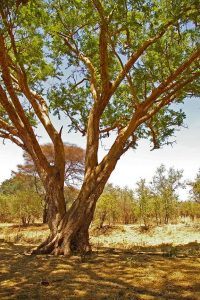
Acacia sieberiana. Photo: M.Coates Palgrave. Source: Flora of Zimbabwe
on the left. This shape may protect the foliage from grazing pressure and fire damage. A.sieberiana is common in vlei areas that are often burnt and it has a loose flaky bark that may insulate the trunk during fires. Most Acacia trees are short lived and regenerate from seeds. In open grasslands many seedlings are burnt or grazed down year after year and eventually die. Along Churchill Avenue in Harare the seedlings are slashed every year and so therefore few juveniles to replace the magnificent trees that have been dying back over the past few years. Some gardeners also forget that many trees are short lived and wonder why the tree becomes progressively sparser when they week out seedlings and fail to plant new trees.
34.5 Besides noting Mazowe Dam on the right look into the woodland to the left of the road and spot a slightly smaller tree with bright green to yellow green foliage. This distinctive colour belongs to Monotes glaber which is common in this woodland at the base of these hills although it also grows well on the poorer sands associated with granites and so is a fine tree to spot from the car.
37 It is rare to pass the orange kiosk at Mazowe Dam Wall without stopping for fruit and admiring the different indigenous fig trees. Standing behind and above the kiosk is a tall Ficus salicifolia, the name means with leaves folia, like a willow, Salix, and note how they hand downwards. Compare this growth with the Ficus ingens growing immediately to the right of the kiosk. Here the dark green leaves stick out proudly and have a distinctly spear shape with two lobes near the base and two side veins that join the middle vein at the base of the leaf. These “basal veins” are common in most fig trees and so the Ficus thonningii that grows to the left of the kiosk is usual as it lacks these basal veins. All figs have a milky sap and edible fruit, although often the wild figs are filled with insects that add to their crunch texture. If you have time a narrow path leads down to the riverine forest below the dam wall. Because of the lower altitude and extra moisture this forest has a number of species that do not occur around Harare.
Beyond the kiosk the road passes Mazowe and along the right is a wet area with Acacia polyacantha that have pale trunks and look most striking when covered in spikes of cream flowers in October or November. The name polyacantha means many thorns, these are hooked and form large woody bosses on the trunk.
At the Concession/Mvurwi turnoff the km pegs begin again from 0.
5.5 Beyond the 5.5 peg is a field on the left with two tall Parinari curatellifolia. These provide edible fruit, the muhacha, and the wood has silica crystals which make it a difficult tree to chop. On the edge of the field is a large yellow trunked Ficus sycomorus to remind you of this again. On the left opposite Concession is a granite outcrop, the first one so far along this road. But this is a small local intrusion and does not signify the end of the greenstone belt. The early dry season the fine trees on this hill are spectacular. This tree, Hymenodictyon floribundum, often clings to cracks in the granite and makes a fine red autumn show.
16.5 Beyond Riverside there is a display of white-trunked Acacia polyacantha just before the river itself.
23.0 The end of the greenstone is marked by a bold line of granite hills up ahead. From here to Centenary the soils change to granitic sands which tend to be poorer in nutrients and so tobacco and cattle farming become more important. Look out for a bright green bush with sticky leaves that point vertically upwards.
27.5 This is Dodonaea viscose and is dominant around the 27.5 and 28.5 peg. The female trees bear a fruit with three wings that turn bright red.
33.0 The large leafed trees on the right are Uapaca kirkiana
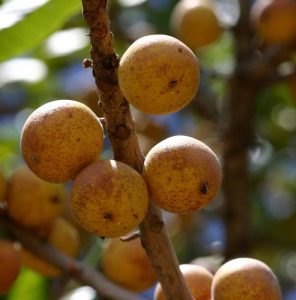
Uapaca kirkiana. Photo: Bart Wursten. Source: Flora of Zimbabwe
which is another important indigenous tree that has separate male and female trees. These continue along the road for the next to km and become dominant between the 43 and 42.5 km pigs. The large leaves are hard and become brittle when they dry so they crunch underfoot. These trees are frost tender so are used to indicate frost free areas. They are common in poor shallow soils on slopes. The female trees bear tasty fruit, mushange, in the beginning of the rainy season. These seeds already contain green chlorophyll while in the fruit and they must start growing almost immediately or else they die.
50.5 After Msonedi the road passes through excellent miombo woodland with musasa trees, Brachystegia spiciformis, one of the commonest trees on the Highveld.
55.5 Remember the Paranari? Here it grows in open grassland and has a characteristic lollipop shape.
56 The Great Dyke is an important feature that runs from the north to south through the country. The road travels parallel to the dyke which can be seen way over on the left horizon.
55.8 Revise Dodonea and Monotes, both bright green, but the one a shrub, the other a tree.
61 Pines and gums were introduced to provide timber and firewood, and thus reduce the pressure on indigenous woodland. They do create an atmosphere of their own but cannot match the subtle attraction and ever-changing diversity of our indigenous woodland. This difference needs to be appreciated. The success of these introductions can be measured, not by how may woodlots we have, but by how healthy the surrounding woodland is.
-Kim Damstra.
THE HURLEY’S FARM, CENTENARY, JANUARY 24 – 25 1987
As we left Harare the drizzle started and we wondered what the weekend would bring. It did bring some rain, but we were given a very warm welcome and generous hospitality and I believe our recorder, Pat, noted over 100 species. I might add that each one of these species is very special, but unfortunately there is only space for some of the highlights. There were a number of trees with yellow flowers obviously like Pterocarpus rotundifolius, round leaved bloodwood, but with the leaves all wrong. It transpired that this was Pterocarpus rotundifolius subsp. polyanathus var. martini which has 4 to 8 pairs of leaflets as opposed to the subsp. rontunifolius which only has 1-3 pairs. Another species which caused a lot of discussion was Combretum collinum, which is commonly called the Variable Combretum anyway, and ran very true to its name. At the time we thought we had found 3 of the 4 subspecies but on further examination of the leaves, I think there were only 2, one of them very variable. The fruit are usually fairly consistent, too small to be Combretum zeyheri and too big to be anything else and a nice chocolate brown. There was Combretum hereroensis with its small mouse-ear-like leaves some furry and some totally glabrous with the centre of the pod dark chocolate fading towards the wings and Combreum fragrans with its big leaves in 3’s, now to be called Combretum adenogonium. “Aden” comes from Greek and means gland and “gone”, also from Greek, refers to regeneration. There must be glands in the flowers, perhaps that is where the “fragrans” comes from.
On the Sunday morning, after a super evening of wining and dining under the stars in convivial company, and then a magnificent breakfast, a few of us braved the weather. We found on a small rocky outcrop a plant that looked like a suffrutex form of Brachystegia glaucescens. This has now been identified as Cryptosepalum maraviense, common in Zambia but coming no further south in Zimbabwe than Chinhoyi. It has little annual flag shoots which we saw when we looked properly. These also bear the pink flowers and little pods in September to November. It is also a member of CEASALPINOIDEAE. A little wax like flower proved to be Glossotehua spathulum, a member of the Ascelpia family. The rain, welcome in the area, rather restricted our movement on the Sunday morning, but after a very good midday meal, we were able to venture out again finding Garcinia buchananii in fruit, Hymenodictyon floribundum with its characteristic paddles at the base of the seed spikes and many more …..; before the rain sent us scuttling back for tea and we sadly packed ourselves into the cars and returned to Harare.
At and Ag Hurley, thank you so much, it really was a fantastic weekend. Thanks also to the Nethersoles, the Fenton Wells and others who made our stay so enjoyable.
-Meg Coates Palgrave
P.S. ON CENTENARY : A mystery tree on Saturday morning on the first of At’s anthills had simple, obovate leaves with pale lateral veins and zigzag branchlets. We carried the leaves around all morning. It could belong to the EUPHORBIACEAE as it was not unlike a Bridelia but there were no stipules although often these fall early. The zigzag was too pronounced for ANNONACEAE and the obovate shape too angular. Meg suggested Baphia which I have since seen is similar. Somewhere around lunch time the features crystallized out to form Diospyros squarrosa of the EBENACEAE, no stipules, that Tom had shown us alongside Ficus stuhlmannii in the Botanical gardens only three weeks earlier. Small specimens grew on most of the anthills we climbed in the afternoon and identification was confirmed by the pale bark of a taller specimen on a large anthill. Tom always jokes on how little we remember from the walks, well some of helps sometimes. Also on this last anthill was a tall Maerua angolensis with a pod like a bead necklace high out of reach. It is not common around Harare, I can only think of one specimen on the Bayley’s farm. Once again, thanks to the Centenary folk for a memorable weekend of treeing, eating and socializing.
-Kim Damstra.
THE ROAD TO SKIES FROM THE BERG
Where do you see a baobab on the Harare – Bulawayo road? What is the most important tree on the Somabula Flats? All this and more in this guide for travelers.
HARARE
What about taking the old Bulawayo Road, continue east along North Avenue. You are now in the Harare Greenstone Belt which consists of ancient larval rock, deposited in Horizontal layers many years ago but since buckled when molten rock welled upwards pushing the greenstone into belts. This particular belt stretches in an arch from Harare northwards to Mazowe and Glendale then eastwards to Shamva. Notice how all the ridges run from north to south, these are layers of banded ironstone that resist weathering. The new sports stadium on the left is constructed against one of these ridges, as is Heroes’ Acre, in the distance on the left. The greenstone belts are rich in minerals as well, where the golf course is on the right, the Golden Quarry Mine is fairly close on the left. Most of the road to Bulawayo links one band of greenstone to another. As this is where many of the minerals are and because greenstone weathers to fertile red soil excellent for maize farming if the rainfall is reliable, you end up with a false impression of Zimbabwe’s fertility. The road by passes a vast expanse of granite and gneiss.
After the railway line at Tynwald another banded ironstone ridge is represented by the two hills on either side of the road. These hills were once well wooded with what is called Miombo Woodland consisting mainly of msasa,
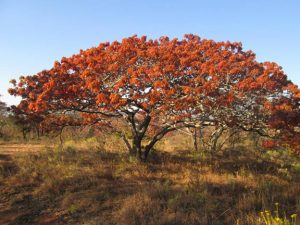
Brachystegia spiciformis. Photo Ann Sinclair.
Brachystegia spiciformis, and munondo, Julbernardia globiflora, but the growth of high density residential areas in Harare’s satellite suburbs has increased the pressure for firewood so these hills stand naked. Annual fires kill of the regeneration to maintain grassland.
Beyond these hills tall Acacia sieberiana flank the road. This species of muunga, thorn tree, has a characteristic flat top and usually a thick bark with papery flakes. These features protect the trees from fire.The road leaves greenstone just before Rainham Dams on the right. Tall cactus like plants stand out on the termite mounds, these are not really cacti, that family comes from America, usually. These plants belong to the EUPHORBACEAE and are called Euhorbia ingens. Ingens means huge and these are fine examples. The King of Mauretania, Juba, christened the genus Euphorbia after his corpulent physician Euphorbus. After crossing the flat gneiss the road joins up with the next Greenstone Belt that extends to about half way between Norton and Selous. After crossing a banded ironstone ridge this ridge runs parallel to the road and forms the natural barrier for Lake MacIlwaine.
37.5 Just before Norton the road passes through a grove of Acacia galpinii with magnificent trees on either side of the road. In September these trees bear red spikes that change to yellow as the flowers open.
51.5 All of a sudden the Acacia species come into their own. On the right are pale trunks of a Acacia polyacantha and on the left here different species speed by. These are not easily distinguished by the beginner. Acacia nilotica has dark bark and tangled branches that knit to form a tight bus where as Acacia karroo and Acacia rehmanniana have red bark and stick upwards.
56.5 The tall, gangly Acacia trees on the left with a bottle brush appearance to the branches are Acacia gerrardii, a most satisfactory tree to spot from the car.
57.5 Note the yellow trunks of the sycamore fig, Ficus sycomorus, close to the road. 58.0 Just before the 58.5 peg is the tall trunk of a pod mahogany, Afzelia quanzensis, on the right verge. An unusual spot for this species as it usually grows amongst rocks and at lower altitudes.
59.5 Before the 60 peg is another good F.sycamorus on the right. Beyond 60 Acacia gerrardii are plentiful.
61.0 The altitude has dropped since Harare and the heat increased and so here are the first mopane trees, Colophospermum mopane. These trees have their own character with sinuous black trunks. The wood is hard and still stands unrotted in Lake Kariba. They are often associated with bare sodic, sodium enriched, soils with poor drainage.
64.0 Under the powerlines and onto the Great Dyke at 650.0 where a bare belt of grassland indicates the first strip of toxic Serpentine that begins beyond Centenary and runs down the country to near West Nicholson. Most of the way it forms a ridge and helps to dam the waters of Darwendale and Ngezi Dams. Right here it is fairly flat. The serpentine forms a trough that is exposed on either side of the Dyke, the centre of the Dyke consists of more fertile soils with tall woodland, note the Acacia gerrardii.
69.0 The large pale trunked trees are Acacia polyacantha.
71.0 Tall mufuti,
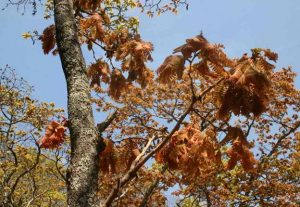
Brachystegia boehmii. Bart Wursten. Source: Flora of Zimbabwe.
Brachystegia boemhii grace the roadside. Their fibrous bark strips off in long strands that provide moisture when chewed and cordage as well.
75.5 Just before the 76.0 peg is a large fine leafed Albizia amara on the right. These are similar to the Acacia genus but lack thorns. The Dyke has a number of species that are seldom found elsewhere. Immediately beyond the Serui River on the left is a grove of wild wisteria, Bolusanthus speciosus that turns into a purple haze in September. A closer investigation will reveal a pagoda like tree, each level is ornamented with stubby branches that stick up vertically. The tree is appropriately known as Terminalia randii.
79.0 I missed the second strip of Serpentine so now the road is off the Dyke and onto gneiss until it joins the next Greenstone Belt just before Chegutu. While on the gneiss look out for mopane, 85.5peg, the gangly Acacia gerrardii and mufuti.
98.5 While crossing the Mupfure look back along the right bank to admire the sausage tree, Kigelia africana that is often hung with enormous sausage like fruit. Many folk claim to have cured their skin cancer by rubbing slices of this fruit on regularly.
100.0 The mopane woodland is mixed on the sandy soils derived from the gneiss. Before arriving in Chegutu the road joins the next Greenstone Belt, a narrow strip this time but one that snakes down almost continuously all the way to Gweru.
110.5 Acacia karroo is common on the left. This tree became the “mufushwa” tree when a TV advert illustrated “Do you have mufushwa, dry, hair” with a Stroebel Peter hairstyle that sticks out all around the crown. This silhouette is practically a diagnostic feature for this species.
131.0 Somewhere between the 131 peg and the railway crossing are two strangling fig trees on the left. These trees are not parasites but simply seek a high place from which to grow, away from grazers, fire and soil fungi. Their roots will eventually surround the host tree and strangle it to death.
145.0 The altitude has dropped to below 1200, Harare kopje is 1536m, and before beginning the incline to Bulawayo, Sauerdale is 1477m, the road just enters baobab territory with the notable specimen on the right bedecked with table cloths. Spot a few more also on the right.
149.5 A row of the rubber edge, Euphorbia tirucalli, as planted along the railway line to the right. Small ‘animals’ closely related to the trypanosomes that cause sleeping sickness swim around in this plant’s milky latex. Between 1900 and 1930 it was falsely believed that these could be transmitted to humans and cattle. If this were so all hope of ridding the country of sleeping sickness would be doomed.
156.0 Note the smooth pale bark and fine foliage on the mountain ‘acacia’,
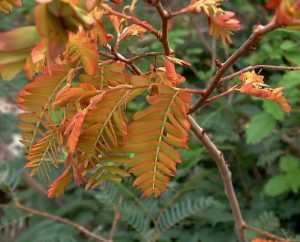
Brachystegia tamarindoides. Photo: R.Burrett. Source: Flora of Zimbabwe
Brachystegia glaucescens on the right.158.0 Cross the Msweswe to find the silver leaves on the pagoda like Terminalia sericea.
166.5 Return to mopane and prepare for a sudden change to Acacia woodland, 167.0, and back to miombo woodland, 107.5.
186.0 Just before the 186.5 peg is a tall leadwood, Combretum imberbe next to the road on the left. Notorious timber for breaking tools.
198.0 Sable Chemicals an important source of nitrogenous fertilizer.
201.0 Once again the Brachystegia glaucescens on the slopes at 201.0 and 204.5. Kwekwe introduces the marula trees. A fine specimen grows to the left of the last circle in the town. Already the altitude is 100m higher than Gatooma.
217.5 The leaflets of the marula, Sclerocarya birrea, hang downwards in the wet season, the trees are bare in the dry season.
220.5 Brachystegia glaucescens. 221.5 Acacia polyacantha 233.5 Acacia karroo.
235.5 Return to mopane for a while.
248.0 Silver Terminalia sericea.
255.0 Brachystegia glaucescens on the left. 260.5 The tree aloe, Aloe excela on the left. Gwelo marks the end of this Greenstone Belt and it quite a crossing to the next small patch that starts at Shangani. Getting there requires crossing the gneiss which we have carefully avoided up to now. Here the gneiss forms the broad expanse of the Somabula Flats. This expanse of grassland is unlike any of the journey so far. Do not be confused by the short stretch of woodland between the 16 and 20 pegs, this is a small stretch of Kroo Sand deposited on top of the gneiss and which supports a fine woodland. In contrast to the huge granite boulders of Domboshawa or the Matopos, the gneissic areas are flatter with less exposed rock. The only shade on the Somabula Flats is provided by the muhacha, Paranari curatellifolia with their characteristic lollipop shape. These trees sometimes exude a peculiar smell like an overflowing sewer, particularly around dusk, so they are not suitable camp sites. Their fruit is tasty and from the distinct browse line the cattle seem to trim the lower branches.
48.5 The rubber hedge again, Euphorbia tirucelli.
56.5 After crossing the Shangani River the road returns to a patch of Greenstone up to Nsiza, 88.0. Night had settled by the time the communal lands, presumable on poor gneissic soil, slid past the car, so this account fades out here too.
-Kim Damstra
BULAWAYO – JANUARY 31ST 1987
A small party from Harare travelled to Bulawayo for the Matabeleland Branch’s February meeting. This was on the Sunday and we therefore had the very difficult choice of venues to do a spot of treeing on the Saturday.
We eventually decided on some Kalahari sand vegetation and Ken chose Kloof Farm, Helensvale Black, near Pasippas a short distance along the Nyamdhlovu road and belonging to Mrs. Anne Visser. That Saturday became known as the Acacia day but before I go into that any further, the real highlight of our visit to the Kalahari sands was finding the teak Baikiaea plurijuga in flower. The flowers are about 5cm in diameter and can vary from pink to mauve, the ones we saw were mainly mauve. They are bore on spies and the velvety brown buds open from the bottom, usually with only one or two flowers open at once. But the spikes are numerous and stand up well above the leaves and the massed effect is quite beautiful. The flowers eventually develop into a flattened velvety pods which are widest towards the apex and then shortly narrow to a little beak. We found a few young pods as well. This is member of CAESALPINOIDEAE with the flowers above the leaves and velvety pods one is not surprised to learn that it is fairly closely related to Julbernardia.
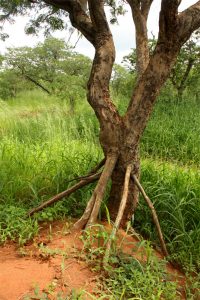
Baikiaea plurijuga. Photo: Bart Wursten. Source: Flora of Zimbabwe
The leaves of Baikaea plurijuga are pinnate with 4 – 5 pairs of leaflets which tend to turn on the rachis giving them a louvered appearance, a characteristic shared with Brachystegia allenii on the Zambezi escarpment and Burkea africana of which there were also many. In fact we had to look careful for the presence of velvet tips and bipinnate leaves to make sure that we were not mistaking the two.
Only the Teak ‘trees’ were in flower, as opposed to the many ‘bushes’. As ‘bushes’ there is a problem with bush encroachment and certainly some of the areas we saw the ‘bush’ was very thick. We understand that aerial spraying is being done to try to control the problem. This seems a very drastic measure and from our lofty distance we wondered if selective cutting although rather expensive, or the Savory method of putting in a vast number of cattle might be less devastating and perhaps more effective.
Before we return to the fascination of the Acacia, another highlight was seeing Ricinodendron rautenii, Manketti Tree, a member of EUPHORBIACEAE with digitate leaves, i.e. leaves with 5 – 7 leaflets which all grow out from the same point on the petiole like those of Vitex payos or the baobab and the resemblance to the baobab does not stop there. The Manketti Tree has a very smooth bark, golden or greenish and without leaves remarkable baobab like albeit a very slender one. One of the names which Eve Palmer gives it is featherweight Tree and this must refer to the wood which is incredibly light almost like balsa wood, as we found from the chips left from one that had unfortunately been chopped down, probably to be used for making drums. There are separate male and female flowers probably on different trees, the nut looks very like a large fat almond and the kernel is edible. We were again shown the Manketti tree with a pool of water in the hollow in the roots just below ground level, with the entrance rubbed smooth and bearing testimony to the many little animals and birds that make use of the phenomenon. We again speculated as to when comes the water, there appeared to be no visible inlet or outlet, the roots forming an apparently perfect container. Finding something like this certainly gives credence to the bushmen being able to obtain water from trees in otherwise dry areas even during times of drought.
And so back to the Acacia species. When there are unfamiliar Acacia trees on the side of the road one just has to stop and see what they are! The first one was Acacia arenaria. This has a short bole with the branches arising from almost ground level in fact many of them had a very bushy habit with somewhat zigzag branches. We did not have too much trouble identifying it. It is one of the straight thorned species and had globose flowers white with a slight pinkish tinge. The leaves have many pinnae with many small leaflets and there are two glands, one between the terminal pair of leaflets and a large oval one on the very short petiole just below the lower most pair of leaflets. Our next stop was to admire Acacia fleckii. I had always thought that this also had a bush like habit and was delighted with the ‘trees’ we saw. This is one of the hookers with flowers in spikes and we had no difficulty in distinguishing it from Acacia erubescens. The leaf had a short petiole less than 1 cm with a conspicuous gland and the length of the two largest pinnae was less than the length of the rachis which had no glands at all. We saw Acacia gerrardii with its leaves and white flowers tightly ranked along the branches rather like a bottle brush and the dots and streaks of orange showing through the grey hairs on the new growth. We spent a little time lassoing the lovely velvety pods of Acacia erioloba, Camel thorn, and then came across one with the pods well within reach when we were also able to see the leaves with only 1 or 2 pairs of pinnae. We passed impenetrable thickets of Acacia karroo, sweet thorn and saw Acacia nilotica, scented pod Acacia, easily recognized when in pod with its pods constricted between the seeds, but also with a characteristic densely twiggy rounded crown appearance and anastomosing bark. That is a good word! It means that the bark as longitudinal fissures which join, split and rejoin rather like the bark of Terminalia.
The other highlights, the ones I collected and popped into my book. Grewia retinervis, Kalahari Sand Grewia, in flower, Rhus pyroides with its spine tipped branchlets, pyroides means “like a pear” and probably does not refer to any burning sensation one might obtain if pricked by one of the spines. Combretum psidiodes aptly named the peeling twig Combretum, with chunks of bark peeling off the twigs and bright shiny viscous red pods which when held against the light, the little drops of gum could be seen shining in the sun.
All in all a very exciting and stimulating morning. Thank you to Ken and Betty and Geoff and Ruth, we really enjoyed it all, including the welcome refreshments that were much appreciated.
In the afternoon we had planned a quiet potter among the trees at Hillside Dams. They are big and beautiful and special and many of the Bulawayo members turned out to join us and that was also special.
There were magnificent Acacia galpinii much too tall for us to count the pinnae or see the hooked thorns. Mr. Bob Drummond has again very kindly identified the specimen which I brought back. I shall send the named specimen to Bulawayo for them to have a look at. The big Rhus near the car park on the other side is Rhus leptodictya, the Rock Rhus. Rhus tenuipes the Serpentine Rhus has longer narrower leaves. The other Rhus with rounder leaves and a slightly pink tinge to the veins is Rhus tenuinervis which we called the Commiphora rhus seeing in the leaves some resemblance to the trifoliolate commiphoras. Talking of which when out of ones own tree area one should keep ones big mouth shut. What I started calling Commiphora africana was in fact Commiphora schimperi which is also trifoliolate, also has spine tipped branchlets and also has a brownish flaking bark revealing a green under bark but the leaflets are shiny green and without any hairs and I think the little pieces coming off the bark are a bit bigger. It was super seeing it. The Olea which we were not happy about being an Olea was in fact not an Olea after all, but Buddleja saligna the Olive Buddleja. It grows naturally in the Matopos so it is interesting to speculate whether that one was planted or not. And coming back to the thorny problem of the Acacias, we looked at Pterolobium stellatum, Redwing and it was pointed out that along the rachis at each pair of pinnae there is a pair of hooked thorns underneath and a straight thorn on top and that as Acacias do not have this it is possible to distinguish between them.
The end of a lovely day and we thank the Bulawayo folk for their very warm welcome and Shirley and Ian van Rensburg for their hospitality.
-Meg Coates Palgrave
P.S. ON THE RICINODENDRON. The mystery of the waterhole in the Ricinodendron on Kloof Farm is an interesting one. It seems mostly unlikely that the tree is actually secreting the water by some form of guttation and so although the hollow appears to be lined with tree, somewhere in the mud at the bottom there mUst be an opening, so that the secret lies in the underlying geology. Three layers overlie the Basement Complex in this area. Firstly, an expanse of Karoo Sands that have been consolidated in places to form the famous Pasipas Sandstone used for so many of the colonial offices. The Karoo Period ended with a vast outpouring of larva that solidified as basalt. The Baikaea woodland, with the Ricinodendron, occurs on a pocket of fine, unconsolidated Kalahari Sand which was blown in by wind and deposited on the basalt. The saucer of basalt results in an aquifer and somehow the roots of the Ricinodendron must penetrate the aquifer and provide a channel up which the water, which is under pressure, anyway, moves to form this natural spring.
-Kim Damstra
QUIET WATERS CONSERVATION AREA : FALCON COLEGE, ESIGODINI, SUNDAY, 1ST FEBRUARY
From Bulawayo the Beit Bridge Road winds its way down off the Bulawayo Greenstone Belt and drops almost 300m before reaching Esigodini and Falcon College. Here we were greeted with a welcome tea on the lawns. The Bulawayo fold are such characters I am not sure whether the trees outshine the people or visa versa.
Quiet Waters is a conservation area adjacent to Falcon and administered by the College. They hope to provide the area as a venue for conservation education. The area includes a number of geological features with associated vegetation. The convoy set out past Dichrostachys cinerea, Sclerocarya birrea, Combretum hereroense, Lannea discolor, Diplorynchus condylocarpon, Euclea divinorum and Combretum apiculatum, but we had to stop at an Ormocarpum trichocarpum, the large caterpillar pod. This is the first time I have seen it outside the Botanic Gardens and these were covered in mauve pea like flowers and even displayed the hairy caterpillar pods that distinguish it from Combretum kirkii, the species that is more common around Harare. Later on we noted how often the trunks of O.trichocarpum are covered with a thick layer of lichens, much more so than the surrounding trees. Alongside grew Commiphora schimperi. Moving to and over the Tetete Stream we passed Bolusanthus speciosus, Combretum imberbe, Pterocarpus rotundifolius subsp. rotundifolius, Pappea capensis, pioneer thickets of Acacia karroo, Diospyros lyciodes and spectacular bosses on Acacia nigrescens. I have been waiting to see
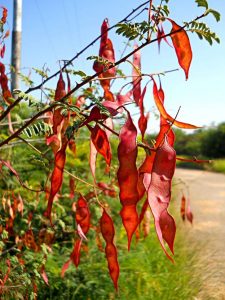
Acacia chariessa. Photo: L.E. Lauritsen. Source: Flora of Zimbabwe
Acacia chariessa since Charles Sykes first wrote about it. Davidson and Jeppe describe it as a “graceful feathery shrub up to 3m high”. It belongs to the group with scattered prickles and was covered I spikes of cream flowers with developing pods of a bright red colour. It is endemic to Zimbabwe. A stop to look at the fame fence revealed Ziziphus mucronata, Cassine matabelica, Securinega virosa, Acacia gerardii, Flacourtia indica and Dombeya rotundifolia. A few tall crystal bark, Crossopteryx febrifuga grew along the road with Pseudolachnostylis maprouneifolia, Bauhinia thonningii, Pterocarpus angolensis, Azanza garkaena, I believe that for all of Harare bomba zonke, the snot apples in Bulawayo taste much sweeter and snottier, and Steganotaenia araliacea. A notable tree on the crest of the schist (schist belt = greenstone belt = gold belt) was a Mundulea sericea in flower but with much paler leaves than those we usually see around Harare. This is referred to in the name sericea which means silky, due to the hairs that cover the leaves. Other finds included Commiphora africana, the shrub Lippia javanica with aromatic leaves, Bridelia mollis, Rhus tenuinervis, Rhus lancea, Securidaca longepedunculata, tall but shrubby Cissus cornifolia of the grape family with arthritic elbows, Albizia amara and Albizia antunesiana, Pavetta schumaniana with its black colonies of bacteria in the leaves, Ximenia caffra, Grewia flavenscens with square stems, Peltophorum africana, Strychos spinosa, Terminalia sericea, Burkea africana with velvet growing tips and Euclea natalensis with characteristically dirty leaves.
The vegetation is different at the base of Usandisa, a tall granite outcrop. Here we found a number of fig species. At the picnic site is Ficus thonningii in which there are not three distinct veins from the base of the leaf, figs usually have 3 veins, so this is different, and the mid vein runs right to the end of the leaf. The smooth leafed Ficus sur grew between the F.thonningii and a magnificent Ficus glumosa on a rock, was called Ficus sonderi. Ficus glumosa is the only fig with hairy leaves, not sand papery, where the leaf breadth exceeds two thirds of the length and loses its hairs as the leaf ages. If it fits all the rest but the leaf top is permanently hairy then it may be Ficus tettensis which also grows in the area. Under this tree was Cussonia arborea and the semi parasitic tree Osyria lanceolata. Most members of this family, the SANTALACEAE, connect their roots to neighbouring trees from which they derive nutrients. Walking around the base of the granite we found Faurea saligna, Cassine matabelica, Carissa edulis, Clerodendron glabrum, Grewia monticola and a Ficus natalesis. This latter tree is very similar to F.thonningii but the leaves have a more lacquered appearance and tend to be truncated. The mid vein often stops short of the apex and apparently the petioles on the same twig are often of a constant length whereas on F.thonningii the petioles on the same twig are usually of a variable length. I agree the difference sounds subtle, but it seems to be real enough. Falcon is very keen to maintain a natural atmosphere within Quiet Waters and have a policy of non interference as far as parents and scholars are concerned. Not fully appreciating this, I intruded on a party that happened to be sitting under a spectacular Canthium lactescens which lactated freely on demand. Also present here were Vitex payos and Tapiphyllum velutinum. I apologize to the staff. Along the road we round Rhus pyroides, Psydrax livida, was Canthium huillense, and then tall Acacia sieberiana and A.polyacantha in the vlei area. On the way back to lunch we passed a grove of Parinari curatellifolia, muhacha, the trifoliolate leaves on Rhoicissus tridentata, a Maytenus heterophylla, Turraea nilotica, Ximenia americana, Euclea crispa and Combretum hereroense. Lunch was very sociable; it is a joy to put faces to names, and characters to faces.
The afternoon walk on the schist was most enjoyable. We were all able to compare the taste of ripe Ximenia americana with Ximenia caffra, which shows how many fruit there were for such a large party. The skin of both is very bitter and X.americana with its orange berry has a distinct smell of cyanide. Both are sweet but the seed becomes bitter if sucked for too long. The cyanide smell is interesting because Ximenia belongs in the OLACACEAE along with Olax, a genus in which we can sometimes detect cyanide in the leaves. Having eaten these berries we found three members with blackened mouths, they had mistaken the Euclea crispa for some sort of olive, Olea and eaten the black berries off a Jasminium that was climbing amongst the branches. Well, no deaths have been reported yet. Close to the cars we found Ehretia rigida. The Ehretia obtusifolia around Harare is so covered in the bristly hairs that characterize the BORAGINACEAE I could not accept this smooth leaf as an Ehretia when first shown it at Hillside Dams the previous day. Then finding a Cassine transvaalesis in flower I was convinced the Ehretia was misidentified until Ruth Archer held both leaves up to see that Cassine the lateral veins are not easily seen on the under surface whereas on Ehretia distinct lateral veins are present. Only then did I remember that Brian Best always runs his fingernail around the margin of Ehretia to look for hairs – it is not necessary for E.obtusifolia, but is for E.rigida and Brian comes from Bulawayo.
With the long journey back to Harare we could not stay too late and so hit the road. We really must thank all the staff at Falcon, we learned a lot, and also the Bulawayo fold for all their support. It was greatly appreciated.
-Kim Damstra.
P.S ON QUIET WATERS : Having looked at Acacias the previous day and in particular Acacia fleckii when Andy produced a piece of Acacia with paired hooked thorns, a petiole obviously longer than 1cm and the leaf obviously broader than long I pronounced it to be Acacia erubescens and so it has proved to be, I was also given a piece of very papery curly bark.
There was also Acacia chariessa one of the species with scattered prickles and flowers in spikes. The distinguishing feature seems to be that although the prickles are scattered there are a few in pairs at the nodes and the little piece I brought back with me demonstrates this well.
-Meg Coates Palgrave
CAROLINA FARM, SUNDAY 15TH FEBRUARY 1987
Bringing archaeology into a Tree Society outing may seem odd but not when one reflects that this is a subject which has contact with many of the sciences, and particularly botany, for man must have relied on vegetation for some of his food from his earliest beginnings. And so we spent a while during our visit to Caroline Farm while Mr. Tomlinson led us to some rocks where there are rock paintings and also some rough stone walling. The rock paintings, so numerous in Zimbabwe, were indeed painted by Bushmen, though possibly some of the rather crude and clearly not so old paints on some sites may have been added by later occupants of the country.
Practically all the rock paints found in Zimbabwe are found on granite rocks and so those who lived in the area where Carolina lies, on the granite sandveld, enjoyed an environment which supplied water, food, both vegetable an animal, and shelter among rocks which also provided the flat granite surfaces they used for painting on.
How far back in time our Zimbabwe rock paints go is not know, but research in the Matopos has shown that some of the paintings there existed at least 18 000 years ago.
What motivated the Bushmen to paint the pictures is a question which has exercised the archaeologists for many years. Detailed studies of some of the many paintings in South Africa, coupled with a close study of the Religious beliefs and lore recorded when bushmen were more numerous and less influenced by civilization there than their descendants are today (for there are still some living in the north of Botswana and into Namibia) has resulted in a great increase in interest in the paintings, and an increasing acceptance of the idea, dealt with extensively in the writings of Dr. J. D. Lewis Williams of the University of the Witwatersrand, that it is these beliefs and practices that lie behind the paintings.
What materials were used in making the paint has been the subject of debate for many years, but no definite conclusions have yet been reached. It is generally accepted that crushed coloured rocks and earths were the basis, and for the medium in which these were mixed a feasible suggestion was made some time ago that the sap of the Candelabra, Euphorbia, was used. Whatever the ingredients, in shelters where no water has penetrated the paintings are often remarkably well preserved and show the wonderful powers of observation and artistic talent of the Bushmen.
The paints we saw on Carolina were small friezes under shallow overhangs, but water has in some places trickled down the face from cracks in the rocks above and, probably with some chemical action with the granite, has obliterated parts of the friezes.
There are undoubtedly thousands of rock paints sites yet to be discovered in this country, and anyone finding rock paintings, or indeed any other ancient remains, such as rock engravings, old living sites with daga from the walls of old huts, potsherds, metal working, stone walling and Stone Age remains is helping the archaeologists by reporting these sites to the nearest museum. It is not generally known that all these remains are by law under the protection of the Museums and Monuments.
Mr. Tomlinson showed us some of the rough stone walling, built to fill gaps between boulders, and often forming enclosures. This type of walling is known as Refuge, and it is thought to be a relic of the days when the Shona were often raided, and so took refuge in the kopje with their livestock. It is probably dated to the 19th century, but further study remains to be done on this question.
We were most grateful to Mr. Tomlinson for showing us these sites which lie in such beautiful surroundings.
-Peggy Izzett
OUTING ON SUNDAY 15TH FEBRUARY 1987 TO CAROLINA FARM
This month we were the guests of David and Pauline Tomlinson on their farm off the Skyline-Norton Road, Harare South.
After collecting our hosts from the home station our crocodile of motorcars wound its way through reaped tobacco lands to a wild kopje area within the game fenced conservation project, for our morning perambulations.
Before looking at trees we enjoyed a brief talk by Peggy Izzet on the Pre-history of the site at which there are both bushman paintings and “refuge” walling of relatively recent origin.
Turning to trees I followed Kim’s group around the perimeter of the kopje. In the cool shade of the under storey to one side of the kopje we saw Rhus longipes with a tri-foliate leaf entire about the margin and with a relatively smooth surface. This we compared with Allophylus africanus, also tri-foliate but with a furry surface and scalloped margin. The distinguishing feature which was very obvious was the presence of “hairy armpits” i.e. hairy pockets in the axils of the veins with the midrib which decidedly made this Allophylus. For those with a keen nose the Rhus has a characteristic “Rhus” smell which is not detected in Allophylus. The Allophylus which has males and females on different trees was heavily in flower and young fruit.
In this glade we were able to compare Turraea nilotica with Vangueria infausta. The former a member of the mahogany family, MELIACEAE has alternate simple leaves. A useful feature is that the midrib appears to have been “pulled” through the leaf like a drawstring. The Vangueria belongs to the RUBIACEAE, coffee, gardenias, etc, and like all others in the family has opposite simple leaves and bears an inter petiolar stipule on either side of the stem at the node. Shortly after, we also saw Vangueriopsis lanciflora of the same family and easily confused with Vangueria infausta. We noted how the leaf of the ”Vangueria is hairier” and Vangueriopsis bark rubs a red powder. Another guide notes was the viral infestation on the leaf of the Vangueria which is not seen on Vangueriopsis. Yet another member of the RUBIACEAE in the same shady glade was Canthium lactescens, complete with inter petiolar stipules. Kim showed how it lactates when the terminal bud is squeezed a drop of milk exudes. This is not sap, but apparently a lubricant for the growing bud.
We saw a number of old friends – Rhoicissus revoilii with arthritic joints, Peltophorum africanum coming into yellow flower, Clerodendron glabrum, with pungent leaves coming off the stem in whorls of 3, Swartzia madagascariensis with unripe snake bean pods and the largest leaflet at the end of the leaf bearing alternate leaflets, and then Flacourtia indica being visited by an orange butterfly Phalanta phalanatha which lays its eggs exclusively on the leaves of FLACOURTIACEAE and SALICACEAE, giving weight to the argument of some taxonomist that these families are more closely related than the orthodox texts give them credit for.
A young Ficus thonningii showed the signs of a series of “flushes” i.e. periods of dormancy followed by active growth. This was evidenced by a progression from small leaves to large, the small ones having grown at the start of the flush and the larger ones being the later ones.
Moving off the kopje a little way onto the granite derived sand-veld, a rather different picture was presented. This area was dominated by
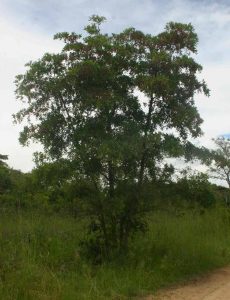
Terminalia sericea. Photo: Bart Wursten. Source Flora of Zimbabwe.
Terminalia sericea some of which were bearing fruit quite heavily. A number of other trees preferring or not uncommon on sandveld were seen such as Parinari curatellifolia, many good looking Ochna pulchra, Pseudolachnostylis maprouneifolia, Securidaca longepedunculata, Combretum apiculatum and Gardenia volkensii.
The list was long and many other trees were avidly discussed but the one new fact which stuck with me relates more to the scrambling liana/creeper, sometimes just a tree, Pterolobium stellatum, well known for its overabundance of prickles and also for its sprays of cream flowers and later its red wing fruit. Without flowers or fruit, this is easily confused with some of the scrambling acacias, but the magical feature of Pterolobium is that on the leaf rachis where each pinna comes off there are two backward pointing prickles on the underside and one forward pointing prickle on the upper side, an arrangement which is foreign o the acacias and special to Pterolobium.
After a most enjoyable morning’s walk we retired to the cool shade and green lawns of the Tomlinson garden for lunch. A number of us oohed and aahed at an enormous fallen over Dodonaea viscosa spreading over the lawn in one corner, the speculation being that this could only have grown to such size in such completely fire protected precencts for it is well known to be very fire tender.
Our thanks to David and Pauline
-Phil Haxen.
The afternoon walk took the form of a visit to the Tomlinson’s game area. This land, some 2 000 hectares, borders on the McIlwaine game park. It is fenced off from it but there is sure to be some migration of small and some larger animals through the fence. The Tomlinson’s aim is to provide suitable habitat for endangered species of Zimbabwe, Sable, eland, wildebeest, tsessebe, ostrich, impala and giraffe are a few of the species at present resident here. The game area is not open to the public.
With little hope of seeing animals in the heat of the afternoon we set out again to look at trees. The farm is on granitic sand and the area dotted with termitaria. On one such mound was a Vangueria, either randii or apiculata, of spectacular size. Fortunately the fruit was present and was very distinctively asymmetric with its crown of persistent sepals not opposite the fruit stalk, but at about 45o to the expected axis of the fruit. We have a problem distinguishing the 2 species mentioned above, but it was most likely V.randii.
The area was liberally dotted with “mermaids” our common name for Ochna pulchra. The pulchra part of the name means beautiful, and our name comes from the fact that the lower bark is scaly but abruptly changes to being very silky smooth and pale above. There were numerous seedlings beneath the trees.
An uncommon find for most of us was Bridelia mollis with its large soft leaves.
In fruit was Sericanthe andongensis, formerly Tricalysia then Neorosea and we are told it may have changed again! It is a member of the RUBIACEAE, as is Vangueria, and what with the name changes and number of plants in the family, most of us seem to have a mental block about identification. After finding Zanha africana many Burkea africana, Ehretia obtusifolia and a tall Strychnos potatorum we played with a thick swarm of lacewings in the long grass. These insects are the adult of an ant lion although they look so very different.
It remains only to thank Mr. Tomlinson for allowing us to wander in his game area, and we wish him luck with the future of the project.
-Cheryl Haxen
KIM DAMSTRA CHAIRMAN


